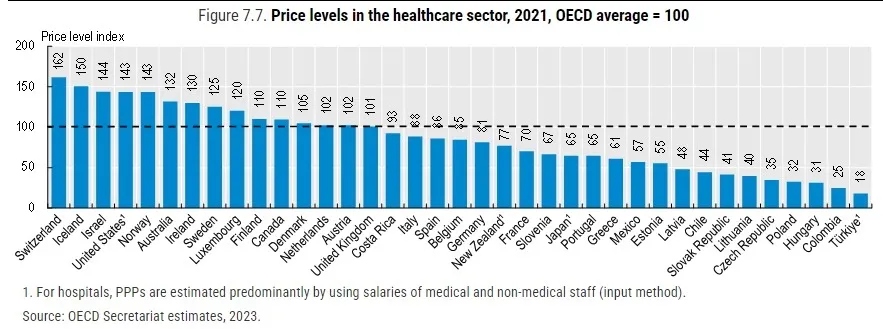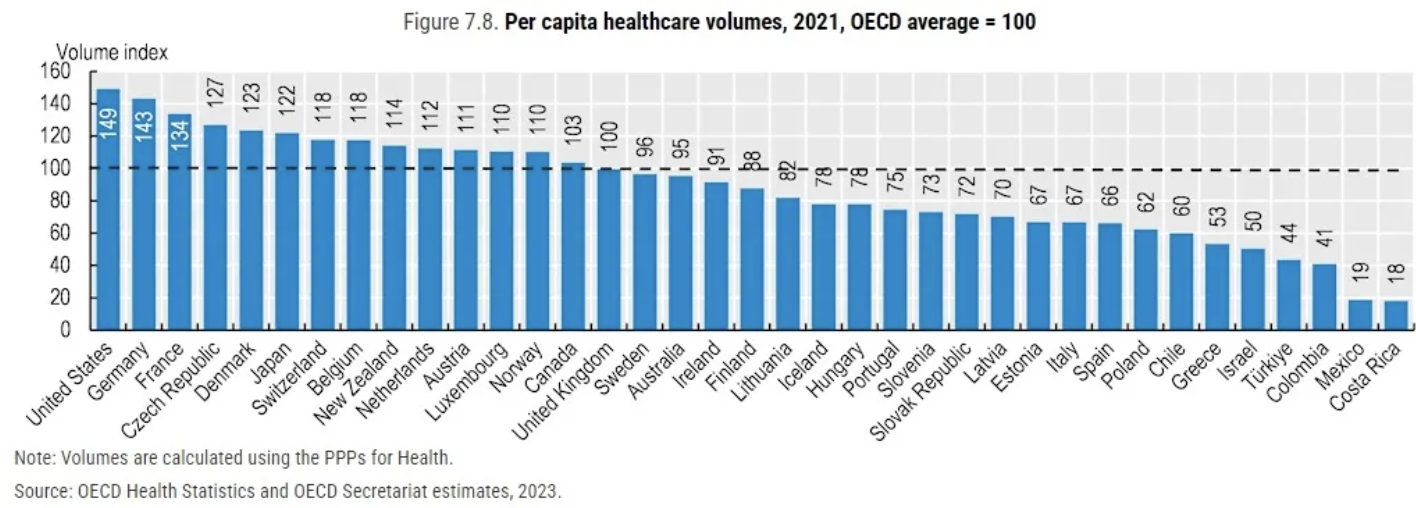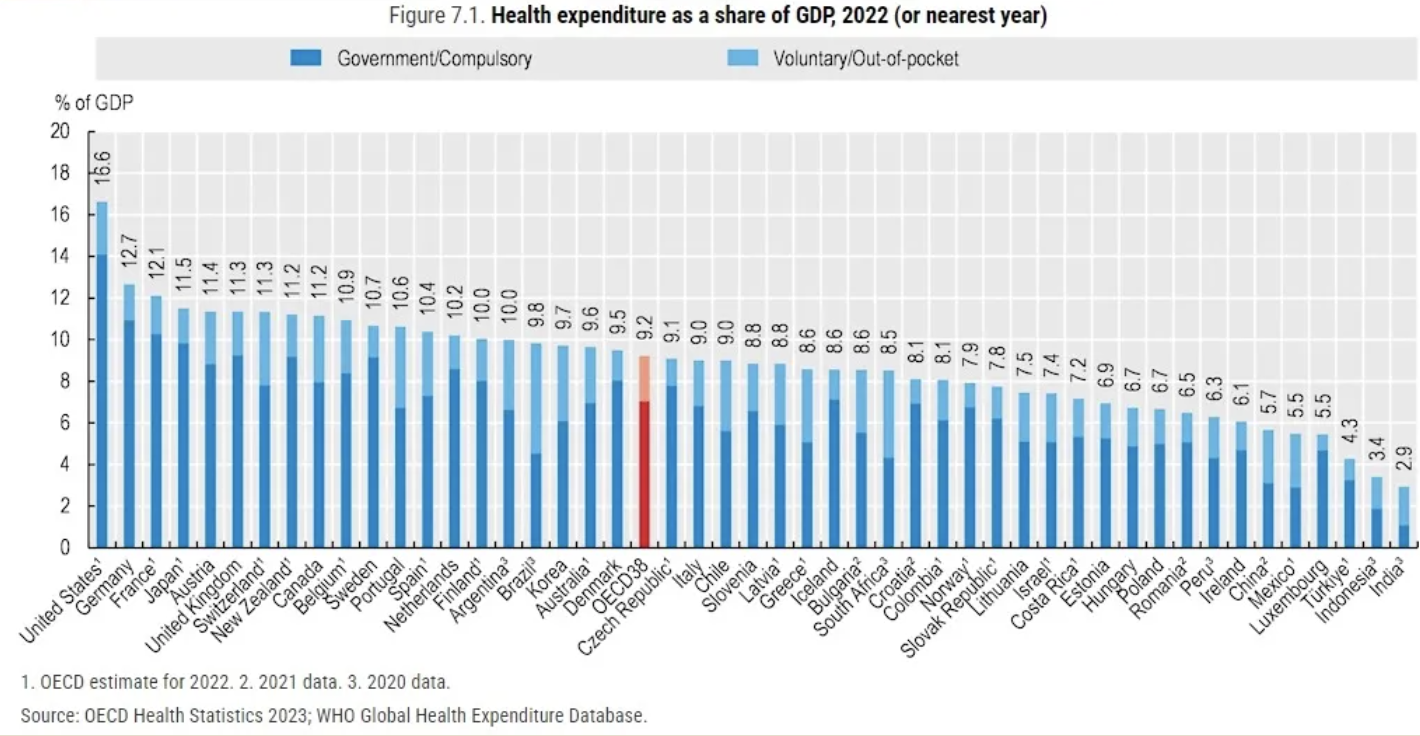Comments
- No comments found

The US spends a much higher share of its GDP on health care than other advanced economies.
But is that higher spending due to higher prices for delivery of health care services or to a greater quantity of health care being provided? This “prices or quantities” question has been around for awhile, but the OECD takes a crack at providing some estimates in the most recent Health At a Glance 2023: OECD Indicators (November 2023).
A primary challenge in comparing health care prices across countries is that the quality of certain kinds of care surely differs. For example, consider a comparison of “patient-days in a hospital.” In the US health care system, a hospital stay is often a very intensive health care experience, where you then do much of the recovery at home; in other countries, a hospital stay might be longer, with expensive technology used only part of the time. Thus, saying that a US hospital day costs more is really about differences in what a “hospital day” means across countries. To compare health care prices, you want to compare (at least roughly) the same services. Then, in addition, you need to compare between US dollars and other currencies.
The OECD has tried to put together a fair price comparison for health care across countries. For the US hospital sector (about 30% of health care costs in most countries), it uses an “input” measure of costs based on the salaries of those working in hospitals. For other aspects of health care, and for hospital care in other countries, it uses “output” measures of price per service (or per drug) provided.
Here’s the result of the OECD measure, which estimates that the price levels in the US are 43% higher than the OECD average.

Working backwards, if you know that total spending is prices multiplied by quantities, and you know the overall spending gap between countries, and you know the differences in price levels, and you can then infer the underlying differences in health care quantities. Using that method, here’s the OECD estimate of the quantities of health care consumed across countries:

I should note that while the OECD has a well-deserved reputation for taking care in doing these kinds of computations as well as they can be done, the method here is necessarily imperfect. For example, differences in administrative costs across countries will not be well-captured here, nor will differences in what kinds of technologies are available across countries.
With such concerns duly noted, it’s interesting that per capita quantities of health care consumed in the US are highest of any country–and remember, this is after adjusting for the higher US price levels for health care. People in Germany and France consume about the same quantities of care as those in the US, but at about one-half the price level. Conversely, the other countries with high health care price levels similar to the US, like Switzerland and Norway, have per capita consumption of health care that is much lower.
Thus, the US economy is the only one near the very top of both the prices and the quantity rankings for health care, which then leads to the high share of the US economy going to health care, compared with other countries. Of course, every dollar the US spends on health care is a dollar of income received by someone in the health care industry, so changing this dynamic is quite difficult.

Timothy Taylor is an American economist. He is managing editor of the Journal of Economic Perspectives, a quarterly academic journal produced at Macalester College and published by the American Economic Association. Taylor received his Bachelor of Arts degree from Haverford College and a master's degree in economics from Stanford University. At Stanford, he was winner of the award for excellent teaching in a large class (more than 30 students) given by the Associated Students of Stanford University. At Minnesota, he was named a Distinguished Lecturer by the Department of Economics and voted Teacher of the Year by the master's degree students at the Hubert H. Humphrey Institute of Public Affairs. Taylor has been a guest speaker for groups of teachers of high school economics, visiting diplomats from eastern Europe, talk-radio shows, and community groups. From 1989 to 1997, Professor Taylor wrote an economics opinion column for the San Jose Mercury-News. He has published multiple lectures on economics through The Teaching Company. With Rudolph Penner and Isabel Sawhill, he is co-author of Updating America's Social Contract (2000), whose first chapter provided an early radical centrist perspective, "An Agenda for the Radical Middle". Taylor is also the author of The Instant Economist: Everything You Need to Know About How the Economy Works, published by the Penguin Group in 2012. The fourth edition of Taylor's Principles of Economics textbook was published by Textbook Media in 2017.
Leave your comments
Post comment as a guest